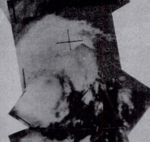1963 North Indian Ocean cyclone season
The 1963 North Indian Ocean cyclone season had no bounds, but cyclones tend to form between April and December, with peaks in May and November. The season has no official bounds but cyclones tend to form between April and December. These dates conventionally delimit the period of each year when most tropical cyclones form in the northern Indian Ocean. There are two main seas in the North Indian Ocean—the Bay of Bengal to the east of the Indian subcontinent and the Arabian Sea to the west of India. The official Regional Specialized Meteorological Centre in this basin is the India Meteorological Department (IMD), while the Joint Typhoon Warning Center releases unofficial advisories. An average of four to six storms form in the North Indian Ocean every season with peaks in May and November.[1] Cyclones occurring between the meridians 45°E and 100°E are included in the season by the IMD.[2]
| 1963 North Indian Ocean cyclone season | |
|---|---|
 Season summary map | |
| Seasonal boundaries | |
| First system formed | January 3, 1963 |
| Last system dissipated | December 7, 1963 |
| Strongest storm | |
| Name | Three |
| • Maximum winds | 240 km/h (150 mph) |
| • Lowest pressure | 920 hPa (mbar) |
| Seasonal statistics | |
| Depressions | 17 |
| Deep depressions | 11 |
| Cyclonic storms | 6 |
| Very severe cyclonic storms | 4 |
| Total fatalities | At least 11,735 |
| Total damage | Unknown |
| Related articles | |
Systems
Deep Depression One
| Deep depression (IMD) | |
 | |
| Duration | January 3 – January 5 |
|---|---|
| Peak intensity | 45 km/h (30 mph) (3-min) |
Extremely Severe Cyclonic Storm Two
| Extremely severe cyclonic storm (IMD) | |
 | |
| Duration | May 18 – May 29 |
|---|---|
| Peak intensity | 195 km/h (120 mph) (3-min) 947 hPa (mbar) |
On May 19, a tropical disturbance formed over the Laccadive Islands, before tracking northwest towards the Arabian peninsula. The system achieved cyclone intensity on May 22. On May 24, a United States Weather Bureau reconnaissance aircraft flew into the 19 km (12 mi) eye of the storm, encountering winds of 193 km/h (120mph).[4] A ship 111 kilometres (69 mi) west of the system reported winds of 68 knots (126 km/h). At Salalah, a strong northerly wind set in during the morning of May 25. Later in the day, winds increased to gale force and a sandstorm reduced visibility to 400 metres (1,300 ft). Later in the day of May 26 winds again increased to gale force and another sandstorm reduced visibility to 500 metres (1,600 ft). As winds increased to 60 knots (110 km/h) the sandstorm became more severe, with visibility restricted to 50 metres (160 ft). Late on the night of the 26th, winds shifted to northeast and heavy rains fell across the region through the morning hours. Skies remained cloudy with periods of rain into May 28. A total of 230 millimetres (9.1 in) was recorded at Salalah.[5][6]
Super Cyclonic Storm Three
| Super cyclonic storm (IMD) | |
 | |
| Duration | May 25 – May 29 |
|---|---|
| Peak intensity | 240 km/h (150 mph) (3-min) 920 hPa (mbar) |
One of the strongest cyclones ever recorded in the Northern Indian Ocean. Had the lowest known pressure in the basin until it was surpassed by the 1977 Andhra Pradesh cyclone.[7] Killed 11,520 people in East Pakistan.[8]
Deep Depression Four
| Deep depression (IMD) | |
 | |
| Duration | June 6 – June 8 |
|---|---|
| Peak intensity | 55 km/h (35 mph) (3-min) 991 hPa (mbar) |
Produced torrential rains over parts of eastern India, peaking at 910 mm (36 in) in Cherrapunji.[9]
Depression Five
| Depression (IMD) | |
 | |
| Duration | June 24 – June 26 |
|---|---|
| Peak intensity | 45 km/h (30 mph) (3-min) 999 hPa (mbar) |
Depression Seven
| Depression (IMD) | |
 | |
| Duration | August 9 – August 14 |
|---|---|
| Peak intensity | 45 km/h (30 mph) (3-min) 991 hPa (mbar) |
Deep Depression Eight
| Deep depression (IMD) | |
 | |
| Duration | August 9 – August 14 |
|---|---|
| Peak intensity | 45 km/h (30 mph) (3-min) 990 hPa (mbar) |
Heavy rains from the storm triggered severe flooding that killed at least 200 people.[13]
Deep Depression Nine
| Deep depression (IMD) | |
 | |
| Duration | September 25 – September 28 |
|---|---|
| Peak intensity | 55 km/h (35 mph) (3-min) 996 hPa (mbar) |
At least 15 people were killed by flooding triggered by the depression in Orissa.[14]
Depression Ten
| Depression (IMD) | |
 | |
| Duration | October 5 – October 7 |
|---|---|
| Peak intensity | 55 km/h (35 mph) (3-min) 995 hPa (mbar) |
Some loss of life was reported in East Pakistan.[15]
Cyclonic Storm Eleven
| Cyclonic storm (IMD) | |
 | |
| Duration | October 13 – October 17 |
|---|---|
| Peak intensity | 75 km/h (45 mph) (3-min) 999 hPa (mbar) |
Very Severe Cyclonic Storm Twelve
| Very severe cyclonic storm (IMD) | |
 | |
| Duration | October 19 – October 24 |
|---|---|
| Peak intensity | 150 km/h (90 mph) (3-min) 984 hPa (mbar) |
Significant damage and flooding took place in India, with some loss of life reported.[17]
Depression Thirteen
| Depression (IMD) | |
 | |
| Duration | October 24 – October 26 |
|---|---|
| Peak intensity | 55 km/h (35 mph) (3-min) |
Very Severe Cyclonic Storm Fourteen
| Very severe cyclonic storm (IMD) | |
 | |
| Duration | October 26 – October 27 |
|---|---|
| Peak intensity | 130 km/h (80 mph) (3-min) 995 hPa (mbar) |
Depression Fifteen
| Depression (IMD) | |
 | |
| Duration | November 24 – November 25 |
|---|---|
| Peak intensity | 45 km/h (30 mph) (3-min) |
Cyclonic Storm Sixteen
| Cyclonic storm (IMD) | |
 | |
| Duration | November 30 – December 7 |
|---|---|
| Peak intensity | 65 km/h (40 mph) (3-min) 1002 hPa (mbar) |
Deep Depression Seventeen
| Deep depression (IMD) | |
 | |
| Duration | December 1 – December 4 |
|---|---|
| Peak intensity | 55 km/h (35 mph) (3-min) 1004 hPa (mbar) |
See also
- List of North Indian Ocean cyclone seasons
- List of notable tropical cyclones
- 1963 Atlantic hurricane season
- 1963 Pacific hurricane season
- 1963 Pacific typhoon season
References
- "IMD Cyclone Warning Services: Tropical Cyclones". India Meteorological Department. Archived from the original on 4 November 2008. Retrieved May 10, 2013.
- "Report on Cyclonic Disturbances Over the North Indian During 2008". India Meteorological Department. January 2009. Archived from the original (PDF) on May 29, 2009. Retrieved May 10, 2013.
- India Meteorological Department (1963). "Annual Summary — Storms & Depressions: Deep depression in the Bay of Bengal" (PDF). India Weather Review: 1–2. Retrieved May 13, 2013.
- David Membery (July 2002). "Monsoon tropical cyclones: Part 2". Weather. 57 (7): 246–255. Bibcode:2002Wthr...57..246M. doi:10.1256/004316502760195911.
- David Membery (July 2002). "Monsoon Tropical Cyclones: Part 2". Weather. Royal Meteorological Society. 57 (7): 247–255. Bibcode:2002Wthr...57..246M. doi:10.1256/004316502760195911.
- India Meteorological Department (1963). "Annual Summary — Storms & Depressions: Severe cyclonic storm in the Arabian Sea" (PDF). India Weather Review: 2–5. Retrieved May 13, 2013.
- India Meteorological Department (1963). "Annual Summary — Storms & Depressions: Severe cyclonic storm in the Bay of Bengal" (PDF). India Weather Review: 6–9. Retrieved May 13, 2013.
- Neil L. Frank; S. A. Husain; National Hurricane Center, Pakistan Meteorological Department (June 1971). <0438:TDTCIH>2.0.CO;2 "The Deadliest Tropical Cyclone in History?". Bulletin of the American Meteorological Society. 52 (6): 438–444. Bibcode:1971BAMS...52..438F. doi:10.1175/1520-0477(1971)052<0438:TDTCIH>2.0.CO;2.
- India Meteorological Department (1963). "Annual Summary — Storms & Depressions: Deep depression in the Bay of Bengal" (PDF). India Weather Review: 9–11. Retrieved May 13, 2013.
- India Meteorological Department (1963). "Annual Summary — Storms & Depressions: Depression in the Bay of Bengal" (PDF). India Weather Review: 11–12. Retrieved May 13, 2013.
- India Meteorological Department (1963). "Annual Summary — Storms & Depressions: Depression in the Bay of Bengal" (PDF). India Weather Review: 12. Retrieved May 13, 2013.
- India Meteorological Department (1963). "Annual Summary — Storms & Depressions: Depression in the Bay of Bengal" (PDF). India Weather Review: 12–13. Retrieved May 13, 2013.
- India Meteorological Department (1963). "Annual Summary — Storms & Depressions: Deep depression in the Bay of Bengal" (PDF). India Weather Review: 13–14. Retrieved May 13, 2013.
- India Meteorological Department (1963). "Annual Summary — Storms & Depressions: Deep depression in the Bay of Bengal" (PDF). India Weather Review: 15. Retrieved May 13, 2013.
- India Meteorological Department (1963). "Annual Summary — Storms & Depressions: Depression in the Bay of Bengal" (PDF). India Weather Review: 16. Retrieved May 13, 2013.
- India Meteorological Department (1963). "Annual Summary — Storms & Depressions: Cyclonic storm in the Arabian Sea" (PDF). India Weather Review: 16–18. Retrieved May 13, 2013.
- India Meteorological Department (1963). "Annual Summary — Storms & Depressions: Severe cyclonic storm in the Bay of Bengal" (PDF). India Weather Review: 18–19. Retrieved May 13, 2013.
- India Meteorological Department (1963). "Annual Summary — Storms & Depressions: Depression in the Bay of Bengal" (PDF). India Weather Review: 20. Retrieved May 13, 2013.
- India Meteorological Department (1963). "Annual Summary — Storms & Depressions: Severe cyclonic storm in the Bay of Bengal" (PDF). India Weather Review: 20–22. Retrieved May 13, 2013.
- India Meteorological Department (1963). "Annual Summary — Storms & Depressions: Depression in the Arabian Sea" (PDF). India Weather Review: 22. Retrieved May 13, 2013.
- India Meteorological Department (1963). "Annual Summary — Storms & Depressions: Cyclonic storm in the Arabian Sea" (PDF). India Weather Review: 22–24. Retrieved May 13, 2013.
- India Meteorological Department (1963). "Annual Summary — Storms & Depressions: Deep depression in the Bay of Bengal" (PDF). India Weather Review: 24–26. Retrieved May 13, 2013.